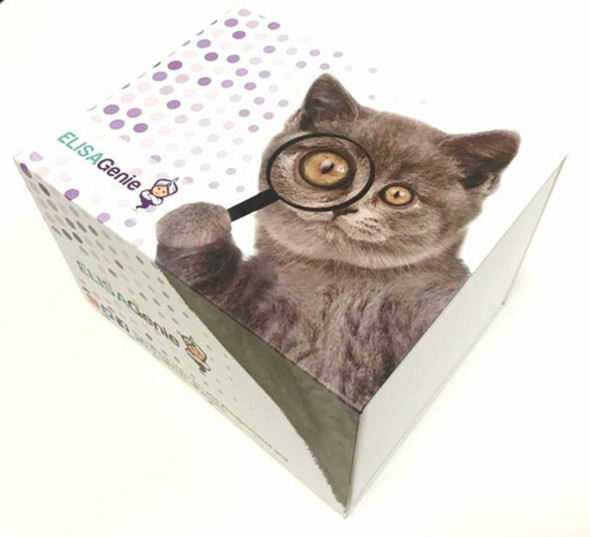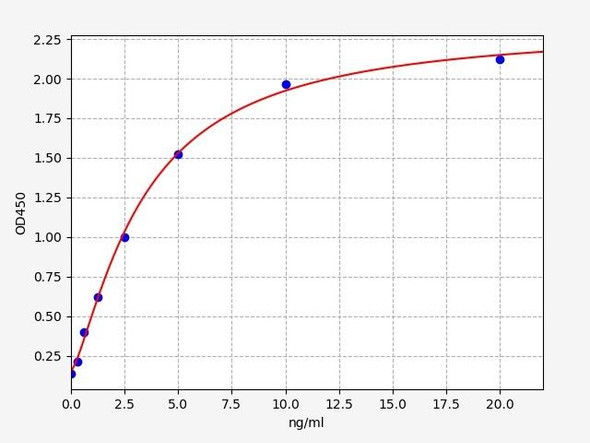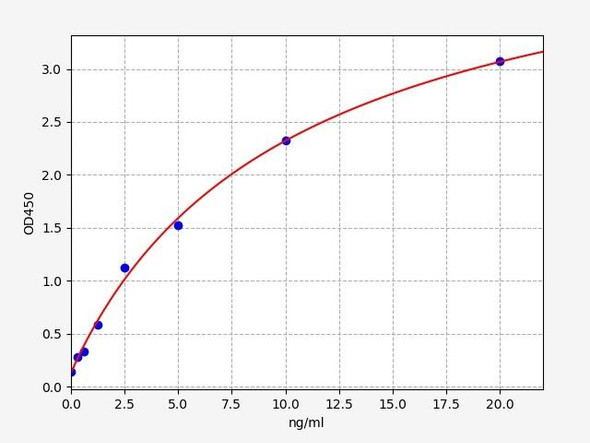Mouse Toll-like receptor 2 (Tlr2) ELISA Kit (MOEB0521)
- SKU:
- MOEB0521
- Product Type:
- ELISA Kit
- Size:
- 96 Assays
- Uniprot:
- Q9QUN7
- Range:
- 0.312-20 ng/mL
- ELISA Type:
- Sandwich
- Synonyms:
- TLR2, CD282, CD282 antigen, TIL4CD282, toll, interleukin 1 receptor-like 4, Toll, interleukin-1 receptor-like protein 4
- Reactivity:
- Mouse
Description
Mouse Toll-like receptor 2 (Tlr2) ELISA Kit
The Mouse Toll-Like Receptor 2 (TLR2) ELISA Kit is specifically designed for the accurate detection of TLR2 levels in mouse serum, plasma, and cell culture supernatants. This kit offers high sensitivity and specificity, ensuring reliable and reproducible results for a variety of research applications.TLR2 is a key protein involved in the immune response, recognizing various pathogen-associated molecular patterns and activating the innate immune system. Dysregulation of TLR2 has been implicated in various inflammatory diseases, making it a valuable biomarker for studying immune activation and developing potential treatments.
The Mouse TLR2 ELISA Kit from Assay Genie provides researchers with a powerful tool to accurately quantify TLR2 levels, allowing for in-depth analysis of immune responses and inflammatory pathways in mouse models. Trust Assay Genie for reliable and high-quality ELISA kits for your research needs.
| Product Name: | Mouse Toll-like receptor 2 (Tlr2) ELISA Kit |
| SKU: | MOEB0521 |
| Size: | 96T |
| Target: | Mouse Toll-like receptor 2 (Tlr2) |
| Synonyms: | CD282 |
| Assay Type: | Sandwich |
| Detection Method: | ELISA |
| Reactivity: | Mouse |
| Detection Range: | 0.312-20ng/mL |
| Sensitivity: | 0.165ng/mL |
| Intra CV: | 5.7% | ||||||||||||||||||||
| Inter CV: | 8.7% | ||||||||||||||||||||
| Linearity: |
| ||||||||||||||||||||
| Recovery: |
| ||||||||||||||||||||
| Function: | Cooperates with LY96 to mediate the innate immune response to bacterial lipoproteins and other microbial cell wall components. Cooperates with TLR1 or TLR6 to mediate the innate immune response to bacterial lipoproteins or lipopeptides. Acts via MYD88 and TRAF6, leading to NF-kappa-B activation, cytokine secretion and the inflammatory response (By similarity) (PubMed:15690042). May also promote apoptosis in response to lipoproteins (By similarity). Forms activation clusters composed of several receptors depending on the ligand, these clusters trigger signaling from the cell surface and subsequently are targeted to the Golgi in a lipid-raft dependent pathway. Forms the cluster TLR2:TLR6:CD14:CD36 in response to diacylated lipopeptides and TLR2:TLR1:CD14 in response to triacylated lipopeptides (By similarity). Recognizes M.tuberculosis major T-antigen EsxA (ESAT-6) which inhibits downstream MYD88-dependent signaling (PubMed:17486091). Acts as the major receptor for M.tuberculosis lipoproteins LprA, LprG, LpqH and PhoS1 (pstS1), in conjunction with TLR1 and for some but not all lipoproteins CD14 and/or CD36. The lipoproteins act as agonists to modulate antigen presenting cell functions in response to the pathogen (PubMed:19362712). Recombinant MPT83 from M.tuberculosis stimulates secretion of cytokines (TNF-alpha, IL-6 and IL-12p40) by mouse macrophage cell lines in a TLR2-dependent fashion, which leads to increased host innate immunity responses against the bacterium (PubMed:22174456). Lung macrophages which express low levels of TLR2 respond poorly to stimulation by M.tuberculosis LpqH (PubMed:19362712). Required for normal uptake of M.tuberculosis, a process that is inhibited by M.tuberculosis LppM (PubMed:27220037). |
| Uniprot: | Q9QUN7 |
| Sample Type: | Serum, plasma, tissue homogenates, cell culture supernates and other biological fluids |
| Specificity: | Natural and recombinant mouse Toll-like receptor 2 |
| Sub Unit: | Interacts with LY96, TLR1 and TLR6 (via extracellular domain). TLR2 seems to exist in heterodimers with either TLR1 or TLR6 before stimulation by the ligand (PubMed:19931471). The heterodimers form bigger oligomers in response to their corresponding ligands as well as further heterotypic associations with other receptors such as CD14 and/or CD36 (By similarity). Binds MYD88 (via TIR domain). Interacts with TICAM1 (By similarity). Interacts with CNPY3 (PubMed:18780723). Interacts with ATG16L1 (By similarity). Interacts with non-modified M.tuberculosis protein MPT83 (PubMed:22174456). |
| Research Area: | Immunology |
| Subcellular Location: | Cell membrane Single-pass type I membrane protein Cytoplasmic vesicle Phagosome membrane Single-pass type I membrane protein Membrane raft Does not reside in lipid rafts before stimulation but accumulates increasingly in the raft upon the presence of the microbial ligand. In response to diacylated lipoproteins, TLR2:TLR6 heterodimers are recruited in lipid rafts, this recruitment determine the intracellular targeting to the Golgi apparatus. Triacylated lipoproteins induce the same mechanism for TLR2:TLR1 heterodimers. |
| Storage: | Please see kit components below for exact storage details |
| Note: | For research use only |
| UniProt Protein Function: | TLR2: Cooperates with LY96 to mediate the innate immune response to bacterial lipoproteins and other microbial cell wall components. Cooperates with TLR1 to mediate the innate immune response to bacterial lipoproteins or lipopeptides. Acts via MYD88 and TRAF6, leading to NF-kappa-B activation, cytokine secretion and the inflammatory response. May also promote apoptosis in response to lipoproteins. Recognizes mycoplasmal macrophage- activating lipopeptide-2kD (MALP-2), soluble tuberculosis factor (STF), phenol-soluble modulin (PSM) and B.burgdorferi outer surface protein A lipoprotein (OspA-L) cooperatively with TLR6. Interacts with LY96, TLR1 and TLR6 (via extracellular domain). Binds MYD88 (via TIR domain). Interacts with TICAM1. Ligand binding induces the formation of a heterodimer with TLR1. Interacts with CNPY3. Highly expressed in peripheral blood leukocytes, in particular in monocytes, in bone marrow, lymph node and in spleen. Also detected in lung and in fetal liver. Levels are low in other tissues. Belongs to the Toll-like receptor family. |
| UniProt Protein Details: | Protein type:Motility/polarity/chemotaxis; Receptor, misc.; Membrane protein, integral; Cell surface; Apoptosis Cellular Component: cell surface; cell projection; membrane; cytoplasm; integral to membrane; plasma membrane; cytoplasmic vesicle; external side of plasma membrane Molecular Function:protein binding; peptidoglycan binding; transmembrane receptor activity; triacylated lipoprotein binding; protein heterodimerization activity; receptor activity; pattern recognition receptor activity; diacylated lipoprotein binding Biological Process: regulation of cytokine secretion; positive regulation of nitric oxide biosynthetic process; positive regulation of interleukin-12 production; positive regulation of leukocyte migration; microglial cell activation; positive regulation of NF-kappaB import into nucleus; leukotriene metabolic process; detection of triacylated bacterial lipoprotein; response to molecule of fungal origin; signal transduction; positive regulation of interleukin-18 production; nitric oxide metabolic process; positive regulation of interleukin-10 production; activation of NF-kappaB transcription factor; positive regulation of interleukin-8 production; negative regulation of cell proliferation; response to molecule of bacterial origin; response to peptidoglycan; positive regulation of interferon-beta production; response to bacterial lipoprotein; positive regulation of oligodendrocyte differentiation; inflammatory response; positive regulation of Wnt receptor signaling pathway; positive regulation of tumor necrosis factor biosynthetic process; negative regulation of interleukin-12 production; immune system process; detection of diacylated bacterial lipoprotein; cell surface pattern recognition receptor signaling pathway; positive regulation of interleukin-6 production; positive regulation of tumor necrosis factor production; positive regulation of toll-like receptor signaling pathway; positive regulation of chemokine production; toll-like receptor 2 signaling pathway; MyD88-dependent toll-like receptor signaling pathway; induction by symbiont of defense-related host nitric oxide production; defense response to Gram-positive bacterium; negative regulation of interleukin-17 production; myelin formation in the central nervous system; response to bacterium; toll-like receptor signaling pathway; innate immune response; immune response; positive regulation of transcription from RNA polymerase II promoter; I-kappaB phosphorylation; chloramphenicol transport; positive regulation of cytokine secretion; positive regulation of nitric-oxide synthase biosynthetic process; positive regulation of inflammatory response |
| UniProt Code: | Q9QUN7 |
| NCBI GenInfo Identifier: | 20140895 |
| NCBI Gene ID: | 24088 |
| NCBI Accession: | Q9QUN7.1 |
| UniProt Secondary Accession: | Q9QUN7,Q3U400, Q9DBC4, |
| UniProt Related Accession: | Q9QUN7 |
| Molecular Weight: | 89,449 Da |
| NCBI Full Name: | Toll-like receptor 2 |
| NCBI Synonym Full Names: | toll-like receptor 2 |
| NCBI Official Symbol: | Tlr2 |
| NCBI Official Synonym Symbols: | Ly105 |
| NCBI Protein Information: | toll-like receptor 2 |
| UniProt Protein Name: | Toll-like receptor 2 |
| UniProt Synonym Protein Names: | CD_antigen: CD282 |
| Protein Family: | Toll-like receptor |
| UniProt Gene Name: | Tlr2 |
| UniProt Entry Name: | TLR2_MOUSE |
| Component | Quantity (96 Assays) | Storage |
| ELISA Microplate (Dismountable) | 8×12 strips | -20°C |
| Lyophilized Standard | 2 | -20°C |
| Sample Diluent | 20ml | -20°C |
| Assay Diluent A | 10mL | -20°C |
| Assay Diluent B | 10mL | -20°C |
| Detection Reagent A | 120µL | -20°C |
| Detection Reagent B | 120µL | -20°C |
| Wash Buffer | 30mL | 4°C |
| Substrate | 10mL | 4°C |
| Stop Solution | 10mL | 4°C |
| Plate Sealer | 5 | - |
Other materials and equipment required:
- Microplate reader with 450 nm wavelength filter
- Multichannel Pipette, Pipette, microcentrifuge tubes and disposable pipette tips
- Incubator
- Deionized or distilled water
- Absorbent paper
- Buffer resevoir
*Note: The below protocol is a sample protocol. Protocols are specific to each batch/lot. For the correct instructions please follow the protocol included in your kit.
Allow all reagents to reach room temperature (Please do not dissolve the reagents at 37°C directly). All the reagents should be mixed thoroughly by gently swirling before pipetting. Avoid foaming. Keep appropriate numbers of strips for 1 experiment and remove extra strips from microtiter plate. Removed strips should be resealed and stored at -20°C until the kits expiry date. Prepare all reagents, working standards and samples as directed in the previous sections. Please predict the concentration before assaying. If values for these are not within the range of the standard curve, users must determine the optimal sample dilutions for their experiments. We recommend running all samples in duplicate.
| Step | |
| 1. | Add Sample: Add 100µL of Standard, Blank, or Sample per well. The blank well is added with Sample diluent. Solutions are added to the bottom of micro ELISA plate well, avoid inside wall touching and foaming as possible. Mix it gently. Cover the plate with sealer we provided. Incubate for 120 minutes at 37°C. |
| 2. | Remove the liquid from each well, don't wash. Add 100µL of Detection Reagent A working solution to each well. Cover with the Plate sealer. Gently tap the plate to ensure thorough mixing. Incubate for 1 hour at 37°C. Note: if Detection Reagent A appears cloudy warm to room temperature until solution is uniform. |
| 3. | Aspirate each well and wash, repeating the process three times. Wash by filling each well with Wash Buffer (approximately 400µL) (a squirt bottle, multi-channel pipette,manifold dispenser or automated washer are needed). Complete removal of liquid at each step is essential. After the last wash, completely remove remaining Wash Buffer by aspirating or decanting. Invert the plate and pat it against thick clean absorbent paper. |
| 4. | Add 100µL of Detection Reagent B working solution to each well. Cover with the Plate sealer. Incubate for 60 minutes at 37°C. |
| 5. | Repeat the wash process for five times as conducted in step 3. |
| 6. | Add 90µL of Substrate Solution to each well. Cover with a new Plate sealer and incubate for 10-20 minutes at 37°C. Protect the plate from light. The reaction time can be shortened or extended according to the actual color change, but this should not exceed more than 30 minutes. When apparent gradient appears in standard wells, user should terminatethe reaction. |
| 7. | Add 50µL of Stop Solution to each well. If color change does not appear uniform, gently tap the plate to ensure thorough mixing. |
| 8. | Determine the optical density (OD value) of each well at once, using a micro-plate reader set to 450 nm. User should open the micro-plate reader in advance, preheat the instrument, and set the testing parameters. |
| 9. | After experiment, store all reagents according to the specified storage temperature respectively until their expiry. |
When carrying out an ELISA assay it is important to prepare your samples in order to achieve the best possible results. Below we have a list of procedures for the preparation of samples for different sample types.
| Sample Type | Protocol |
| Serum | If using serum separator tubes, allow samples to clot for 30 minutes at room temperature. Centrifuge for 10 minutes at 1,000x g. Collect the serum fraction and assay promptly or aliquot and store the samples at -80°C. Avoid multiple freeze-thaw cycles. If serum separator tubes are not being used, allow samples to clot overnight at 2-8°C. Centrifuge for 10 minutes at 1,000x g. Remove serum and assay promptly or aliquot and store the samples at -80°C. Avoid multiple freeze-thaw cycles. |
| Plasma | Collect plasma using EDTA or heparin as an anticoagulant. Centrifuge samples at 4°C for 15 mins at 1000 × g within 30 mins of collection. Collect the plasma fraction and assay promptly or aliquot and store the samples at -80°C. Avoid multiple freeze-thaw cycles. Note: Over haemolysed samples are not suitable for use with this kit. |
| Urine & Cerebrospinal Fluid | Collect the urine (mid-stream) in a sterile container, centrifuge for 20 mins at 2000-3000 rpm. Remove supernatant and assay immediately. If any precipitation is detected, repeat the centrifugation step. A similar protocol can be used for cerebrospinal fluid. |
| Cell culture supernatant | Collect the cell culture media by pipette, followed by centrifugation at 4°C for 20 mins at 1500 rpm. Collect the clear supernatant and assay immediately. |
| Cell lysates | Solubilize cells in lysis buffer and allow to sit on ice for 30 minutes. Centrifuge tubes at 14,000 x g for 5 minutes to remove insoluble material. Aliquot the supernatant into a new tube and discard the remaining whole cell extract. Quantify total protein concentration using a total protein assay. Assay immediately or aliquot and store at ≤ -20 °C. |
| Tissue homogenates | The preparation of tissue homogenates will vary depending upon tissue type. Rinse tissue with 1X PBS to remove excess blood & homogenize in 20ml of 1X PBS (including protease inhibitors) and store overnight at ≤ -20°C. Two freeze-thaw cycles are required to break the cell membranes. To further disrupt the cell membranes you can sonicate the samples. Centrifuge homogenates for 5 mins at 5000xg. Remove the supernatant and assay immediately or aliquot and store at -20°C or -80°C. |
| Tissue lysates | Rinse tissue with PBS, cut into 1-2 mm pieces, and homogenize with a tissue homogenizer in PBS. Add an equal volume of RIPA buffer containing protease inhibitors and lyse tissues at room temperature for 30 minutes with gentle agitation. Centrifuge to remove debris. Quantify total protein concentration using a total protein assay. Assay immediately or aliquot and store at ≤ -20 °C. |
| Breast Milk | Collect milk samples and centrifuge at 10,000 x g for 60 min at 4°C. Aliquot the supernatant and assay. For long term use, store samples at -80°C. Minimize freeze/thaw cycles. |








